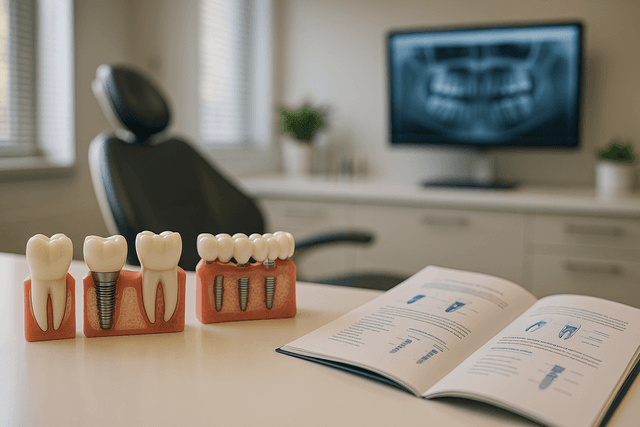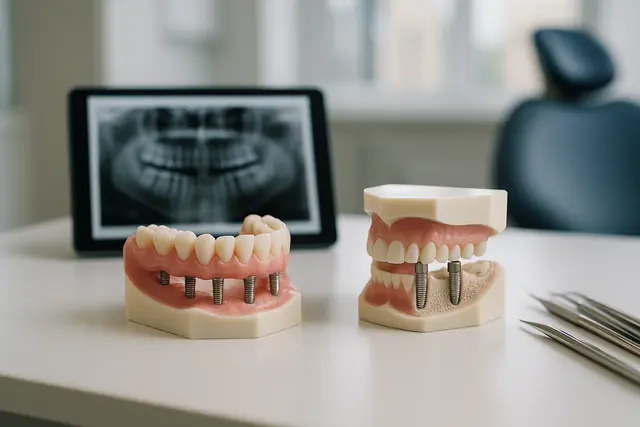Prosthodontics
4 min read
Aug 10, 2025
Different Types of Implants and How to Choose the Right One
Dental implants have transformed the way people restore missing teeth, offering solutions that look, feel, and function like natural teeth. With several types available, each designed for specific needs and conditions, understanding your options is the first step toward regaining a confident smile.

If you’ve been looking in the mirror and wishing those gaps from missing teeth could vanish, you’re not alone. Millions of people turn to dental implants each year to restore their smile, eat comfortably, and feel like themselves again. The best part? Implants are the most common and most reliable long-term solution for replacing lost teeth.
But with so many options, how do you know which dental implant is best for your needs? Let’s break down the main types and how to choose without feeling like you just took a crash course in dental school.
Understanding Dental Implants
Dental implants are artificial tooth roots, usually made of titanium, that are placed into your jaw to support replacement teeth. They look and feel like natural teeth, and with proper dental care, they can last for decades. Getting dental implants involves a dental implant procedure where the implant is placed, allowed to heal, and then topped with a dental crown or another type of restoration. The materials used for dental implants are strong enough to handle everyday chewing while being safe for your body.
Each type of dental implant has its place, depending on your bone structure, health, and goals.
Endosteal Implant
This is the most common type of dental implant. Endosteal implants are inserted directly into your jawbone and are shaped like small screws. After the implant heals and the implants are anchored securely, a dental crown or denture is attached to the implant. Endosteal implants are best for patients with healthy jawbone density. If your jawbone has thinned over time, bone augmentation may be needed before placing an implant into your jawbone.
Subperiosteal Implant
Sometimes, traditional implants are not viable because a patient doesn’t have enough healthy jawbone and doesn’t want or can’t have bone grafting. That’s where subperiosteal implants are placed. Instead of being inserted into the bone, subperiosteal implants are surgically set on top of the jawbone but under the gum tissue. This implant type uses a metal framework to support an endosteal implant alternative. Subperiosteal implants are used less often than endosteal, but they’re a solid implant option when bone loss is an issue.
Zygomatic Implants
If bone loss in the upper jaw is severe, even bone augmentation may not be enough for traditional implants. In those cases, zygomatic implants are the solution. These are longer than traditional dental implants and anchor into the cheekbone rather than the jawbone. They’re highly specialized and considered an advanced dental implant solution, usually performed by implant experts in complex cases.
Mini Dental Implants
Mini dental implants are smaller in diameter than traditional implants, making them perfect when space is tight or bone is thin. Mini dental implants are smaller but still strong enough to support an implant for your needs, such as securing a lower denture. They’re often used when immediate load dental implants are needed or when the patient prefers a less invasive dental implant surgery. Mini implants are a great dental implant option for people looking for faster healing and fewer visits.
All-on-4 Implants
All-on-4 implants use four dental implants to support an entire arch of teeth. This is a popular choice for patients missing most or all of their teeth because it provides a full set of replacement teeth without the need for an implant for each tooth. The four implants are strategically placed to maximize support, sometimes avoiding the need for bone augmentation.
Missing Teeth Solutions Beyond Dentures
If you have one or more missing teeth, you might be tempted to stick with a traditional denture. Dentures can be fine for some, but they can shift, make it harder to eat certain foods, and don’t prevent bone loss in the jaw. Dental implants can help by acting like natural tooth roots, stimulating the jawbone, and holding your replacement teeth firmly in place.
Dental Implant Options for Every Situation
From single tooth implants to multiple implants that support an entire bridge, there’s a range of dental implant options to meet almost any need. Implants are designed to be versatile, and with different dental implant types, your dentist can match you to the one that works for your lifestyle and health.
Choosing the Right Dental Implant
Choosing the right dental implant isn’t just about the cost of dental implants, although that’s part of it. You’ll want to think about how many teeth you’re replacing, your bone health, your budget, and how quickly you want results. Immediate load implants are great if you want a tooth in place right away, but they’re not right for everyone. Traditional implants are the gold standard, but traditional implants are not viable for some patients.
Materials Used for Dental Implants
Most implants are made from titanium, which fuses well with bone and is lightweight yet strong. Some newer materials, like zirconia, are available for patients who prefer a metal-free option. The materials used for dental implants affect how they look, feel, and integrate with your jaw.
Your dental health will play a big role in how well your implant heals. Healthy gums, good brushing habits, and regular dental cleanings keep the tissue around the implant healthy. When implants are anchored properly and cared for, they can last a lifetime.
What Are The Main Types Of Dental Implants?
The most common types are endosteal, subperiosteal, zygomatic, mini dental implants, and All-on-4 implants. Endosteal implants are placed directly into the jawbone and are ideal for patients with good bone density. Subperiosteal implants sit on top of the jawbone under the gums, making them a solution for patients with bone loss who can’t have grafting.
Zygomatic implants anchor into the cheekbone for severe bone loss cases. Mini implants are smaller in diameter, often used to stabilize dentures, and All-on-4 uses four implants to support a full arch of teeth.
How Do I Choose The Right Dental Implant For My Needs?
The right implant depends on your jawbone health, number of teeth being replaced, budget, and how quickly you want results. Your dentist will evaluate your bone density, oral health, and goals to recommend the best option. Some cases may require bone augmentation before implant placement, while others may be suited for immediate load implants for faster results.
What Materials Are Used For Dental Implants?
Most implants are made from titanium, a lightweight and durable metal that integrates well with bone. Titanium has been the standard for decades due to its high success rate. For patients seeking a metal-free option, zirconia implants are available, offering a natural color and good biocompatibility while still being strong enough to handle daily use.
Can Dental Implants Replace More Than One Tooth?
Yes. Dental implants can replace a single tooth, multiple teeth, or even an entire arch. For multiple teeth, implants can support bridges or dentures, reducing the need for an implant at every gap. Solutions like All-on-4 allow a full set of teeth to be supported by just four strategically placed implants, making them efficient and cost-effective.
Read Next
Related Posts

Prosthodontics
Implant Supported Dentures Overview
Missing teeth can impact more than just your smile, they can affect your confidence, comfort, and even your diet. Fortunately, modern dentistry offers a solution that’s both secure and natural-looking: implant-supported dentures. This innovative approach blends the stability of implants with the convenience of dentures to create a long-lasting, life-improving upgrade.
5 min read
Oct 29, 2025

Prosthodontics
Implant Overdentures Explained: The Hybrid Solution to Missing Teeth
Missing teeth can impact everything from your ability to eat to your self-confidence. While traditional dentures have long been a go-to solution, they often fall short in comfort and stability. Implant overdentures offer a modern alternative that combines the security of dental implants with the convenience of removable dentures, a true upgrade for those looking to reclaim their smile.
6 min read
Oct 29, 2025

Prosthodontics
Implant Retained Dentures Explained
Considering implant-retained dentures? You're not alone. As modern dentistry evolves, more people are turning to this secure, natural-feeling alternative to traditional dentures. This guide will walk you through what they are, how they work, and why they might be the solution you've been looking for.
4 min read
Oct 28, 2025
Don’t have time to research every dentist around you?
See why 30k+ patients trusted us